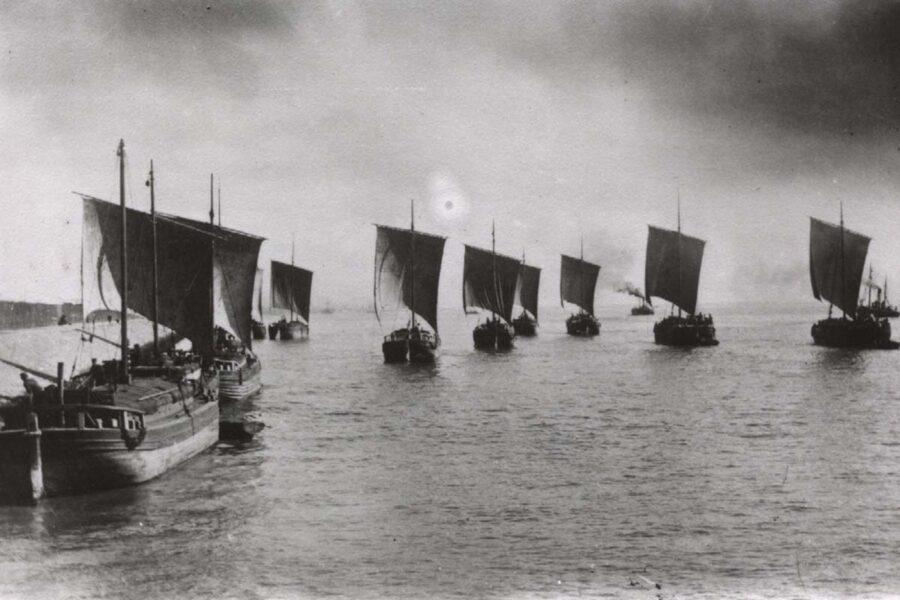Worfolk boats were built to last – and now another centenarian is being restored. John Worrall reports…
Walter ‘Chappie’ Worfolk was a Yorkshire lad.
Born, in 1864, in the small village of Stainforth near Doncaster, he was one of several sons of Joseph Worfolk, master shipwright and boatbuilder. The family had built canal craft for generations, with yards at Agbrigg, Castleford, Worsbury and Rotherham, and indeed any old bit of land if work demanded.
They built Humber keels, the workhorses of the canal system connecting to the Humber, and sloops which traded out to east coast ports, including King’s Lynn. The sloops, of timber or steel, were up to 60ft long with a fore-and-aft rig, and until the late 19th century, the wooden ones were the biggest clinker-built craft in Europe.
Keels, by comparison, were functional tubs, with a square rig and a hull length dictated by the smallest lock on whichever canals they would work, and it was from them that small coastal trading billy-boys evolved. Keel, sloop and billy-boy were all built for capacity: flat bottoms, bluff bows and sterns, and long, straight vertical sides.
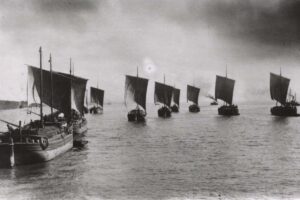
The Yorkshire Worfolks built Humber keels – functional tubs that carried cargos between inland ports on the canal system and to deepwater Hull on the Humber.
In 1886, Walter married Lily Maria Florence Silvester, one of eight children of Thomas Silvester, who traded to King’s Lynn from the Humber. They, in turn, had six children, including sons Gerald (1891) and William (1893).
Lily Maria’s uncle, William Lancaster, had moved to Lynn and become something of a big wheel, with carting, removal and farming interests, and by the late 1890s, he owned the Hulk pub in Bridge Street. It was after Walter’s sister Harriet moved there to work for William that Lily Maria fancied moving south. When William also offered Walter work and accommodation, the family did so, arriving by train on 26 February, 1899.
Walter started off doing fencing and general repair work, but as a time-served shipwright, he took an interest in the local fishing boats and saw that there was no local builder, boats being either self-built or brought in second-hand. He set about changing that.
His first boat, built beside the river Nar on the south side of town, just up from its confluence with the Great Ouse, was a cockler, the 34ft Baden Powell (see Fishing News, 2 February, 2017 for its restoration, and 31 August, 2017 for its relaunch). She was of the traditional double-ender design, which proved he knew what he was doing. Baden Powell fished the Wash under sail until 1928, and then with an engine right through to the mid-1990s.
Then, pretty much worn out, she lay in the Fisher Fleet deteriorating, until she was taken in hand by a group of enthusiasts, who worked on her ashore for several years as time, money and materials allowed. But they eventually got Lottery funding for a professional job, and the Baden Powell returned to the river in July 2017 and began running cruises along Lynn’s historic riverfront. She will do so again as soon as Covid allows.
One thing about the Baden Powell was that she came with good provenance, because during the second half of her career in particular, she was well known to the late Vic Pratt, who joined the Worfolks in 1945 as the only bound apprentice the company ever had – apart from the two sons, Gerald and Bill, who had served time with their father. By then, Walter had retired and the boys were in charge. Vic spoke about the Baden Powell in a telephone conversation with Fishing News in 2009.
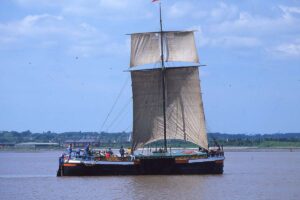
Here’s a later model, the steel-hulled keel Comrade, photographed in May 2004 in the care of the Humber Keel and Sloop Preservation Society (HKSPS).
“She was built for a chap called Cook, and later my father owned her for about six years. He sold her to Ronnie Fisher. She had a Bolander, a Swedish engine, but later they took that out and put a Ford diesel in, and it wasn’t as good. They all had a Bolander back then, or a Thorneycroft Handy Billie. I think it was a two-cylinder in the Baden Powell.
“I worked on her while she was a working boat, particularly when Ronnie had her. I redid the stern post and put the cooling system in – copper pipes on the outside of the hull carrying freshwater to be cooled by the saltwater.
“The Worfolks copied her, but couldn’t do one that was identical, because they were all built by eye. Baden Powell was the best shape. They built one called the Edward V for Charlie Castleton. She was later doubled right from the keel up to the waterline, and above the waterline she was elm, but that made her very heavy.”
He reckoned that Bill and Gerald weren’t the easiest of employers. “They were difficult, but they were good tradesmen, and I got on with them. I was a bound apprentice for seven and a half years, but after I had been there about two years, we were well away. I could call them Bill and Gerald. Old Walter used to come and sit on a stool and watch us work. Gerald was 98 when he died, and Bill was 100 years and four months.”
Years later, when the brothers had retired and Vic had his own company and workshop, Bill used to come and help. “He worked right up until he was 96, but I had to let him go because he got to be a liability. I had to say to him: ‘Bill, you can’t come up any more, for the insurance side.’”
Vic, who died last year, recorded some oral history for the charity Rescue Wooden Boats (see Fishing News, 28 January, 2016), which can be viewed at: bit.ly/2QMdqUu
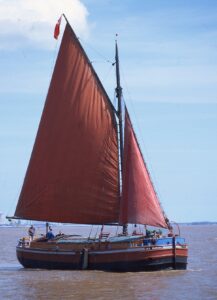
Sloops, like the Amy Howson, seen here at the same time and also in the hands of the HKSPS, were more weatherly with their fore-and-aft rig, and traded coastwise from the Humber.
The last boat the Worfolks built – or technically the last but one – was a small yacht, the 32ft Lady of Lynn, which crossed the Atlantic three times and was last heard of in Vancouver – not inappropriately, because George Vancouver was a King’s Lynn man. She was launched in 1977 for £7,000 for the late Dr Dick Huntsman, a pathologist who had a job lined up in St John’s, Newfoundland. He sailed her across.
“The reason we did that first trip was that the boat had to be moved to Canada,” he said, speaking in 2010. “Bill Worfolk went a little pale when he knew. But he strengthened the hull and lowered the coach roof so that waves could go right over the top.”
That also meant lowering the floor, and she was fitted with a keel of reduced depth but of steel for added weight, with the stipulation that no extra ballast be placed forward of the mast. When Dick asked him about wood preservative, Bill said: “That boat will outlast you. Isn’t that enough?”
Armed optimistically with a copy of Aldard Coles’ Heavy Weather Sailing, Dick and his crew of three, including his 17-year-old daughter Jennifer, set off. There were gales but ‘nothing worse than force eight’, and in heavy weather, they put a bucket on a rope as a sea anchor and went below rather than keep sailing, because there was no chance of getting anyone back if they went over.
But the Lady rode the weather well. “It’s wonderful when the boat groans in poor weather. Wood is so much more comforting than plastic. And she does groan and creak,” said Dick.
Their arrival in Newfoundland impressed local yachties, and relieved Bill Worfolk back in Lynn.
But then a sort of homing instinct kicked in, and when a few bits of minor work became necessary, Dick thought the natural thing would be to get them done back in Lynn by Vic Pratt. By this time the Worfolks had retired. “So she was sailed back, and I renovated her,” said Vic. “I took all the decks out and replaced them.”
The third crossing lasted nearly a year, with Dick’s son Tim heading to Vancouver by the scenic route – Madeira, the Canaries, the Cape Verde islands, the West Indies, Cartegena and the Panama canal. After battling contrary weather – Lady wouldn’t sail closer than 60° – he put her onto a cargo ship up most of the west coast.
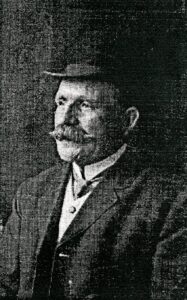
Walter Worfolk – pictured here at the age of 51 – and his family followed other relatives to King’s Lynn.
And the final Worfolk boat? That was a day-sailer for the same family, Norfolk Mawther, which also went to Newfoundland – in a container – where she was known for a while as Newfoundland Girl because ‘mawther’ wasn’t translating.
In the 80 or so years between Baden Powell and Mawther, close to 650 boats of all kinds emerged from the Worfolk workshops. There were fishing boats, crab boats, yachts, barges, pilot cutters and dinghies, including quite a few for the Royal Navy. Some went overseas, like the pilot cutter Christina Lynn, which then did charters on the Cote d’Azur.
There was also the Queen Alexandra, another early fishing boat, which, like Baden Powell, ended up in the Fisher Fleet when her work was done, but she never left and has been rotting there for over two decades. Vic reckoned she was the fastest boat under sail, but they took 7ft off the stern because it used to drag underwater when she was flying.
But now another Worfolk boat, and a big one, is getting the restorative treatment. She is the Britannia, one of a few large smacks the Worfolks built in the early part of the 20th century, and a major feature of the Wash fleet for over 50 years.
Commissioned by Alf Rake of Lynn, she was launched on 10 April, 1915. Britannia was 58ft long on the deck, with a beam of 13½ft, an 8ft draught, and a hollow bow which gave her speed, together with an elegance that wasn’t particularly suited to working the Wash itself, because she couldn’t sit on and dry out. But she was built mainly for whelking on the Dudgeon further out, and her speed to and from port was important. She carried a small boat with which the crew collected the snails.
For 15 or so years, she worked from Lynn, and was regarded as the fastest thing afloat, capable of 14 knots in the right conditions. But in the early 1930s, the whelk fishery died out – it was already in decline when she was launched, and there was a war on then, but perhaps Alf was an optimist – and she was sold to Boston, where an engine was fitted and she turned to trawling.
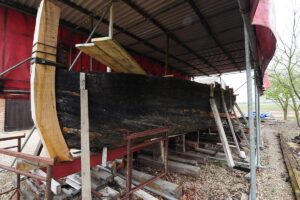
The Baden Powell restoration, seen here in 2012, made sporadic progress as a typical enthusiasts’ project, until Uncle Lottery came up with funds.
In the 1950s, she was from time to time pair-trawling for sprats with another smack, the Nellie and Leslie, but her shape saw her aground more than once, which usually meant her falling over and sinking as the tide went down. But they always got her up, cleaned her out and got her back to work.
After her fishing days eventually finished, she was acquired in the 1970s by Sam and Vicki Samuels, who lived aboard her for many years, first in Lowestoft, where she was rerigged after a fashion, and then in Bristol and various other West Country ports. During all that time, she gradually become more shipshape – Sam is a carpenter and shipwright – and she even got some film work. Two Samuel boys were born along the way.
And then, in 1984, Britannia and the Samuels went north, to the island of Canna in the Inner Hebrides – population 18 – where Sam worked as the island handyman and Britannia was beached on a big spring tide and stayed there on legs for two Scottish winters. Sam rigged up a zip wire for the boys to get ashore, which was really good fun, though the family actually lived in a house.
Later they moved to Portree on Skye for secondary school, and from there Britannia did charters around the Western Isles. And when that finished, she spent a winter in the Canaries, returning to the south coast in 1996.
But all good things must pass, and later that year, she had to be sold. The family stood on Clifton suspension bridge in Bristol and watched their boat go down the Avon without them.
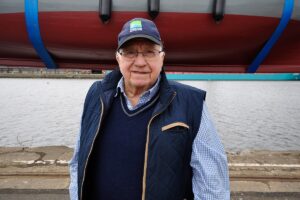
Vic Pratt, pictured in July 2017 when the restored Baden Powell returned to the water, had worked on her a lot when she was fishing.
And yet, what goes round, sometimes comes round. There has been a reunion, and the process has started again.
The restart came in 2013 when Sam and Vicki found Britannia in poor shape at Brixham. With their shared history, there could be no question of allowing her to finish up in some muddy creek being dismembered by the weather, so they bought her back. And anyway, they say, she’s part of Britain’s maritime history from the final years of fishing under sail, and needs to survive as part of the heritage.
They formed the Britannia Sailing Trust with the aim of restoring her and keeping her at work, offering training and work experience in the sailing and maintenance of a traditional boat and – equally importantly these days – close encounters with the marine environment that is such a critical indicator of the health, or otherwise, of the planet.
Britannia was installed under cover 20 miles from the sea, in Winkleigh in Devon, though at the outset, as with the Baden Powell a few years earlier, and as with many – most – wooden boat restorations, there was more enthusiasm than cash, and progress was sporadic and piecemeal.
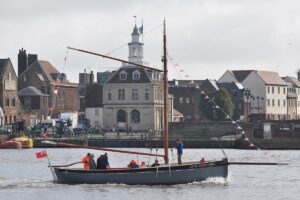
These days, the Baden Powell does cruises along Lynn’s historic waterfront – when Covid allows.
But then, last year, money came through from the Culture Recovery Fund, and a team of boatbuilders has since been at work, lifting both the rate of progress and team morale. Subject to further funding, a provisional relaunch date has even been fixed, for 10 April, 2022, her 107th birthday, even if she might only be watertight by then, rather than ready for the open sea.
And before that, there is her 106th on the 10th of this month, and with things on the way up rather than the way down, that is further cause for cautious celebration, which includes, among other things, an online raffle with excellent nautical prizes. Full details of that and everything else Britannia can be found at: britanniasailingtrust.org
And as soon as Covid allows, Fishing News will be having a closer look and will report on her in detail. She does, after all, have a few stories to tell. And perhaps the ghost of Old Walter will be sitting on a stool, watching progress.

